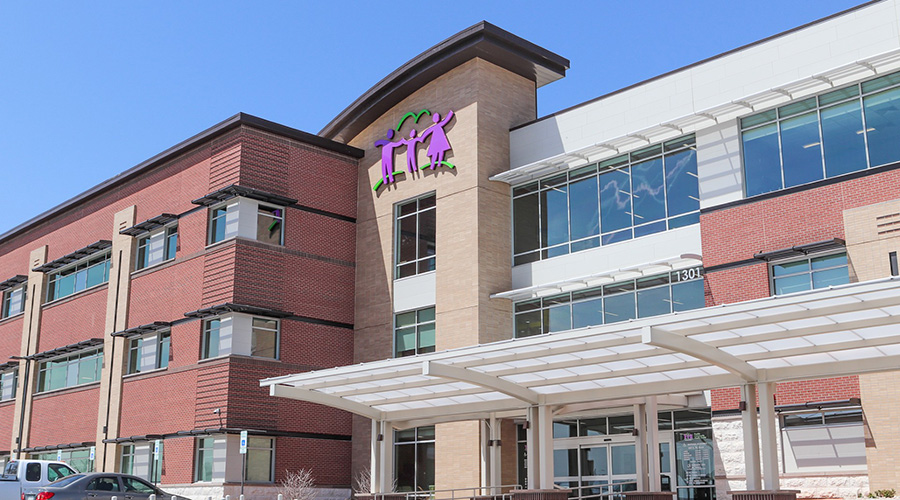Meet the Nation's First Zero Energy Outpatient Healthcare Facility
Pueblo Community Health Center's total site energy use is offset by total site energy production
By Dan Hounsell, Senior Editor
The first zero energy outpatient healthcare facility in North America is not a towering, gleaming architectural marvel. It is not part of a world-renowned healthcare system. In fact, the building was once a grocery store. In short, it does not have the hallmarks many people might look for when discussing an achievement of such stature.
Nonetheless, the Pueblo Community Health Center in Colorado achieved what no other facility of its type had before: Its total site energy use is offset by total site energy production, as verified by the New Buildings Institute. As with most accomplishments of that magnitude, achieving the goal required many contributors.
“There was an amazing amount of collaboration and coordination between the mechanical engineers, the electrical engineers, the architects and us as the owner,” says Donald Moore, the center’s chief executive officer. “That really was critical to our success. Our facilities people got integrally involved up front.”
Aiming for net zero
The Pueblo Community Health Center’s East Side Clinic is a three-story, 64,000-square-foot facility that delivers family practice and primary care services to those in need. It offers behavioral health and dental services, as well as a pharmacy. The clinic’s previous location had presented challenges.
“We previously operated a facility that was literally two blocks away from where we built the East Side clinic,” Moore says. “That building was old and becoming difficult to maintain, and we had no space. We had no space to expand as we saw the need growing in the community, so we acquired the property that formerly was a Safeway grocery store.”
When conversations about a new clinic began, they soon turned to a larger goal than just a one-for-one replacement. The city of Pueblo established a goal to be net zero by 2035 and the clinic’s board members wanted to reflect that community mission.
“We had a goal-setting session where we said the board's vision is that we contribute to the community goal and that we reduce carbon emissions,” Moore says. “How do we incorporate that into our planning?”
Understanding and embracing the goal of zero energy was not always an easy process.
“At the front end of the project, I thought it sounded very pie in the sky,” Moore says. “But we started running the numbers and the economics around a net-zero facility, and what we discovered is two important economic results, in addition to the benefits to the climate.
“No. 1, the return on investment is relatively fast. You can acquire that return on an investment for a very modest overall percentage, an overall for an added investment up front in the cost of the facility. As a percentage of the total project cost, it's pretty small for us. I think it was 6 or 7 percent of the total project cost to do a net-zero build.”
The second result is that net-zero status is a hedge against increasing energy prices.
“We modeled it against energy prices four or five years ago, and we said, ‘This is going to have an ROI of 12 or 13 years,’" Moore says. “Now that we've operated the building for a couple years and we have real data, we think the return on investment is going to be more like a seven- or eight-year payback period. When you're talking about a building with a 50-year life at least, you're banking your savings after less than 20 percent of the useful life of the building.”
Putting pieces in place
The team planning the Pueblo Community Health Center’s new East Side Clinic started the process by trying to identify the process they would use to verify the clinic’s zero energy status. Jason Pitts, the health center’s chief operations officer, says some of the certification processes the team considered seemed onerous.
“There were a lot of things that maybe didn't really contribute to the goal we had,” says Pitts. “In my estimation, working with the (New Buildings Institute) was pretty straightforward in that the certification process. We needed to track our actual energy use and our energy production over the course of 12 months while in operation.”
The next step on the center’s path toward zero energy status for its East Side Clinic was to develop the energy model target. This target was initially based on a 50 percent reduction of the EnergyStar Baseline energy use for a 60,000-square-foot outpatient facility.
The clinic sought to achieve its goal through a range of systems and equipment, including an enhanced building envelope with insulation values in excess of code requirements and fiberglass framed windows. The clinic also features ground source heat pumps, energy recovery ventilation, desuperheaters for domestic hot water, and LED lighting. Photovoltaic (PV) arrays with a 280-kW array on top of the clinic’s parking canopy and roof produces energy on site. Ground-source heat pumps with 4 miles of piping provide heating and cooling for the building.
The result was that the clinic achieved greater than a 50 percent reduction in energy use and a 66 percent cost savings compared to Pueblo Community Health Center’s next most energy-efficient building. The total on-site total energy used was 423,024 kWh, while the on-site total produced from the PV array was 435,744 kWh.
“It definitely was an incremental process,” says Corey Chinn, commissioning manager with Farnsworth Group. “We used energy modeling to determine the amount that the building envelope would contribute, the amount electrical would contribute, the amount mechanical would contribute.”
Moore also points to two unlikely sources of bottom-line benefits related to the project. First, without the amount of insulation installed in the project, the clinic could not have achieved its goal.
“If we did everything else and didn't do the insulation, we wouldn't have gotten our net-zero outcome,” he says. I was amazed at how much of a magnifier that was to the solar and the geothermal and the non-mechanical decisions.”
Second, the project received approval from the clinic’s board in August 2020, just before the nation’s construction industry began to feel the full effects of supply chain issues brought on by the COVID-19 pandemic. The timing proved beneficial.
"The pandemic actually was beneficial to us in our procurement process because no one was taking on big projects at that time, and contractors hadn't run into supply chain problems yet," Moore says. “We literally got all of our (subcontractors) and suppliers under contract the day after the board approved it in August 2020, so we locked in our cost. If we hadn't done that, instead of a $32 million project, it would have been $45 million project with cost increases.”
Making it work
Construction on the Pueblo Community Health Center’s East Side Clinic was completed in late 2021, and the clinic opened to patients in January 2022. While the clinic’s long-term performance related to zero energy now depends on its facilities maintenance and operations staff, the involvement of facilities began early in the planning process.
"Where the facilities got involved was that all this stuff has to be maintained,” Moore says. “There's the caring and feeding of all the systems. As solutions were planned to achieve our goals, there was consultation with facility staff. We don't have a gigantic main facility staff. So it had to be doable within the capacity of our maintenance staff.”
Because the clinic’s energy performance depended on facilities technology that was somewhat out of the ordinary, planners had to be certain that in-house managers and staff were comfortable with it. Staff members toured other facilities to get a sense of what may work for their clinic.
" We made sure to get them involved, especially with technologies that are new and different,” Chinn says. “Getting the O&M staff involved early and designing systems and equipment that they're comfortable with is absolutely part of making this project successful.”
Pitts says his department’s role as the owner's representative in the project’s planning phase included assessing a technology’s performance and maintenance benefits with its cost.
"At the end of the day, of course, we have to, as the owners, decide how much we can afford to do,” he says. “For example, we did have a pretty sophisticated lighting system. But at the end of the day, we decided that that wasn't worth it. We cut that one. It was a great decision, as it turned out because the alternative was really very good. That was my role on the team as the owner's representative during the planning and the project.”
A growing number of organizations nationwide are undertaking new construction and facility upgrades in pursuit of zero energy and carbon emissions goals. To these organizations, key participants in the Pueblo Community Health Clinic’s achievement offer insights into essential considerations in achieving project goals.
Barry Masimer, the East Side Clinic’s facility supervisor, says achieving energy efficiency goals goes well beyond planning and must include attention to facilities operations and maintenance.
"I would suggest that as much as possible, if somebody is planning on doing this, they really spend more time on individual training and understanding the things that need to be maintained, specifically by the facilities department,” Masimer says. “We've had a learning curve, and some of the things that we had to learn were much more technical than anything that we've been used to.”
On the front end of such projects, Chinn emphasizes the role of leadership in the earliest stages of planning.
"This project was really owner driven,” he says. “‘What are you going to do about energy efficiency on the board?’ That's really what drove it. Having owner involvement early allowed us the opportunity to make good decisions early on and stick to them and go forward so. Having the owner on the team and leading like that was a huge advantage to this project.”
Acknowledging the disagreements that can occur within organizations considering projects that address carbon emissions in response to climate change, Moore says there is also a critical business case to be made for such projects.
Says Moore, "Even if you’re totally against believing in climate change, there's a business case for doing this project in a net zero way.”
Dan Hounsell is senior editor for the facilities market. He has more than 30 years of experience writing about facilities maintenance, engineering and management.
Related Topics:












